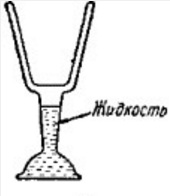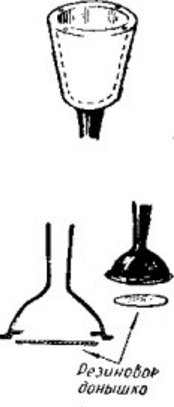 Free technical library
Free technical library
An extraordinary glass. Focus Secret

Directory / Spectacular tricks and their clues
 Comments on the article
Comments on the article
Focus Description:
The magician takes a glass from his illusion table and a bottle of lemonade standing next to it (Fig. 1).

Ris.1
Holding a glass in one hand and a bottle in the other, the performer tries to pour lemonade into the glass, but a miracle happens: the magician has not even had time to bring the bottle closer to the glass, as the glass is already filled to the brim with lemonade. Since the glass is full, the artist no longer needs to hold the bottle in his hand, and he puts it on the table, and brings the glass with the drink to his mouth.
But before the performer had time to take even one sip, there was not a drop left of the drink in the glass. Then the artist again takes the bottle to pour himself some water. And again, he does not have time to bring it to the glass, as the glass is again full. Now the artist, without putting the bottles on the table, without wasting time, drinks the contents of the glass with pleasure. And the glass, like an inexhaustible source, is filled again and again with a pleasant drink without the help of a bottle. Finally, having quenched his thirst, the performer puts the bottle and the miracle glass on the table.
Focus secret:
A glass and a bottle of lemonade are the main props of this trick.
The bottle is the most common, it can be found in everyone. A glass with a secret, it will have to be ordered from a glass blower. Such a glass differs from the usual one in that it is double, its leg is hollow, and the stand is strongly concave (Fig. 2).

Ris.2
The inside of the glass does not touch the bottom of the outside. Between the inner and outer parts of the glass there is a gap of 3 mm. The inner part of the glass is fastened to the edges of the outer part. Four small holes are made in the thickness of this bonded edge for air penetration (Fig. 3)

Ris.3,4
The recess in the stand makes it possible to pour brewed tea there, the color of which matches the color of lemonade. After the tea is poured into the stand, it is necessary to seal its bottom. To do this, a circle of chambered rubber is superimposed on the bottom of the stand, which is glued to it along the edges with BF-2 glue (Fig. 4).
Two-tone glasses are often found in our everyday life. We will take advantage of this circumstance and make our glass of two colors of glass.
Let the glass be white, and the leg and stand blue or red. This will make it possible to hide a secret from the viewer (Fig. 5).

Ris.5
In order to ensure the supply of liquid to the glass in a timely manner, the performer needs to remember the position of the fingers. The glass should be held by the bottom of the stem with the thumb and middle fingers, and the ring finger will perform the main secret function. It should be under a rubber-sealed stand (Fig. 6).

Ris.6
To fill the glass with "lemonade", the artist presses with his ring finger on the rubber bottom of the stand, the liquid rushes up the hollow leg and fills the gap between the inner and outer parts of the glass. This creates the visual effect of focus.
Author: Akopyan A.A.
 We recommend interesting articles Section Spectacular tricks and their clues:
We recommend interesting articles Section Spectacular tricks and their clues:
▪ Inaccessible delicacy
▪ Striking Wheel
▪ The stick gets longer
 See other articles Section Spectacular tricks and their clues.
See other articles Section Spectacular tricks and their clues.
 Read and write useful comments on this article.
Read and write useful comments on this article.
<< Back
 Latest news of science and technology, new electronics:
Latest news of science and technology, new electronics:
Air trap for insects
01.05.2024
Agriculture is one of the key sectors of the economy, and pest control is an integral part of this process. A team of scientists from the Indian Council of Agricultural Research-Central Potato Research Institute (ICAR-CPRI), Shimla, has come up with an innovative solution to this problem - a wind-powered insect air trap. This device addresses the shortcomings of traditional pest control methods by providing real-time insect population data. The trap is powered entirely by wind energy, making it an environmentally friendly solution that requires no power. Its unique design allows monitoring of both harmful and beneficial insects, providing a complete overview of the population in any agricultural area. “By assessing target pests at the right time, we can take necessary measures to control both pests and diseases,” says Kapil ... >>
The threat of space debris to the Earth's magnetic field
01.05.2024
More and more often we hear about an increase in the amount of space debris surrounding our planet. However, it is not only active satellites and spacecraft that contribute to this problem, but also debris from old missions. The growing number of satellites launched by companies like SpaceX creates not only opportunities for the development of the Internet, but also serious threats to space security. Experts are now turning their attention to the potential implications for the Earth's magnetic field. Dr. Jonathan McDowell of the Harvard-Smithsonian Center for Astrophysics emphasizes that companies are rapidly deploying satellite constellations, and the number of satellites could grow to 100 in the next decade. The rapid development of these cosmic armadas of satellites can lead to contamination of the Earth's plasma environment with dangerous debris and a threat to the stability of the magnetosphere. Metal debris from used rockets can disrupt the ionosphere and magnetosphere. Both of these systems play a key role in protecting the atmosphere and maintaining ... >>
Solidification of bulk substances
30.04.2024
There are quite a few mysteries in the world of science, and one of them is the strange behavior of bulk materials. They may behave like a solid but suddenly turn into a flowing liquid. This phenomenon has attracted the attention of many researchers, and we may finally be getting closer to solving this mystery. Imagine sand in an hourglass. It usually flows freely, but in some cases its particles begin to get stuck, turning from a liquid to a solid. This transition has important implications for many areas, from drug production to construction. Researchers from the USA have attempted to describe this phenomenon and come closer to understanding it. In the study, the scientists conducted simulations in the laboratory using data from bags of polystyrene beads. They found that the vibrations within these sets had specific frequencies, meaning that only certain types of vibrations could travel through the material. Received ... >>
 Random news from the Archive
Random news from the Archive Synthetic nerves work in the light
09.04.2016
Researchers from Oxford have created an artificial analogue of the neural circuit: synthetic cells, packed using a 3D printer in a kind of conductive tissue, were able to conduct an electrical impulse.
Cells, tiny drops of water with a volume of 50-100 picoliters, enclosed in a single-layer lipid membrane. Such drops contained not only water, they also contained DNA with genes encoding transmembrane proteins, and all the necessary apparatus for protein synthesis. Transmembrane proteins synthesized in the "cell" formed a through channel in the membrane - this is how an "intercellular contact" appeared between two drops, through which an electrical signal could slip through. The work of the "nerve chain" depended on lighting - the "cells" also contained a special photosensitive protein, which, under the influence of light, bound to DNA and activated the genes of transmembrane proteins recorded in it.
A dense ordered stacking of droplets was achieved, as mentioned above, using a 3D printer. The very technology of XNUMXD printing from such "cells" has been developed for a long time, but now the authors of the work had to develop a new recipe for them, so that both the "cells" themselves and the molecular machines contained in them for transcription (synthesis of RNA copies to DNA) and translation ( protein synthesis to RNA) after passing through the printer would remain in working condition.
Michael J. Booth and his colleagues believe that the main achievements of Michael Booth and his colleagues are that they managed to build a light switch into the nervous chain, and that the propagation of the impulse was not limited to two "cells", that the signal went further - to the third drop, fourth, tenth and etc. In such an artificial system, it is quite possible to study some patterns of impulse propagation through conductive tissues, but in the future, researchers want to combine artificial cells with real ones.
To do this, two technological problems need to be solved: first, the 3D-printed droplet complexes "live" in an oily environment, while real cells need an aqueous solution; secondly, pore proteins in artificial cells are embedded in a single-layer lipid membrane, while in real cells it is two-layered, and it is not known whether a transmembrane protein pore will form between them. Perhaps the contact between an artificial and a real cell can be organized in the form of a synapse, when a certain space remains between the cell membranes, and the impulse is transmitted using special chemical neurotransmitter molecules.
|
 Other interesting news:
Other interesting news:
▪ The mill turns graphene into a semiconductor
▪ Biofuel for aircraft
▪ Art originated in Africa
▪ Created ultra-fast and super-efficient memory
▪ Dogs adversely affect the ecology and climate of the planet
 News feed of science and technology, new electronics
News feed of science and technology, new electronics
 Interesting materials of the Free Technical Library:
Interesting materials of the Free Technical Library:
▪ section of the site Biographies of great scientists. Article selection
▪ Bedlam article. Popular expression
▪ article What species of ants cannot even feed on their own without the help of other slave ants? Detailed answer
▪ article Manager of the Internet project of the Internet marketing department. Job description
▪ article Resonance frequency meter of dynamic head. Encyclopedia of radio electronics and electrical engineering
▪ article Voltage converter, 12/220 volts 5 watts. Encyclopedia of radio electronics and electrical engineering
 Leave your comment on this article:
Leave your comment on this article:
 All languages of this page
All languages of this page
Home page | Library | Articles | Website map | Site Reviews

www.diagram.com.ua
2000-2024







 Arabic
Arabic Bengali
Bengali Chinese
Chinese English
English French
French German
German Hebrew
Hebrew Hindi
Hindi Italian
Italian Japanese
Japanese Korean
Korean Malay
Malay Polish
Polish Portuguese
Portuguese Spanish
Spanish Turkish
Turkish Ukrainian
Ukrainian Vietnamese
Vietnamese






 See other articles Section
See other articles Section 